
Summer brings longer days, outdoor barbecues, and unfortunately, an army of unwanted guests trying to crash your party. From buzzing mosquitoes to stinging wasps, warm weather awakens pest activity across New York state. But with the right prevention strategies, you can enjoy your summer without constantly swatting away insects or worrying about infestations.
Understanding which pests become active during summer months and taking proactive steps can save you from costly treatments and uncomfortable encounters. This comprehensive guide covers the most effective summer pest prevention techniques, helping you protect your home and family throughout the season.
Why Summer Pest Prevention Matters More Than Ever
Summer creates the perfect storm for pest activity. Rising temperatures accelerate insect reproduction cycles, while increased humidity provides ideal breeding conditions. Many pests that remain dormant during winter months suddenly become aggressive in their search for food, water, and shelter.
The consequences of inadequate pest prevention extend beyond mere annoyance. Stinging insects can pose serious health risks, especially for individuals with allergies. Ants can contaminate food supplies, while mosquitoes carry diseases like West Nile virus. Taking preventive action before problems escalate protects both your property and your peace of mind.
Professional pest control experts report that homes with proactive prevention measures experience 60% fewer pest-related service calls during peak summer months. This statistic underscores the value of investing in prevention rather than reactive treatments.
Essential Summer Pest Prevention Strategies
Create Physical Barriers Around Your Property
Your first line of defense involves establishing barriers that prevent pests from accessing your home. Start by inspecting your property’s exterior for potential entry points. Seal cracks and gaps around windows, doors, and foundation walls using weatherproof caulk.
Install or repair window screens to keep flying insects outside where they belong. Check screen integrity regularly, as even small tears can provide entry points for mosquitoes and flies. Door sweeps and weather stripping create additional barriers while improving your home’s energy efficiency.
Consider applying professional-grade exterior treatments around your home’s perimeter. These create invisible barriers that deter ants, spiders, and other crawling insects from approaching your foundation. Many homeowners find that spring and early summer applications provide season-long protection.
Eliminate Water Sources That Attract Pests
Standing water acts like a magnet for numerous summer pests. Mosquitoes require stagnant water for reproduction, while many other insects seek moisture for survival. Conducting a thorough water audit around your property can dramatically reduce pest pressure.
Empty containers that collect rainwater, including flower pots, buckets, and toys. Clean gutters regularly to prevent water accumulation and ensure proper drainage. Fix leaky outdoor faucets and irrigation systems that create persistent wet areas.
Don’t overlook less obvious water sources like clogged drains, pet water bowls left outside overnight, and air conditioning condensation. Even small amounts of standing water can support mosquito breeding cycles, so thoroughness pays dividends.
Maintain Your Landscape to Discourage Pest Activity
Strategic landscaping choices can significantly impact pest populations around your home. Trim vegetation away from your house exterior, creating a clear zone that reduces pest highways into your living spaces. Overgrown bushes and tree branches touching your roof provide convenient access routes for various insects and wildlife.
Keep grass cut short and remove debris piles where pests might shelter. Mulch beds should be maintained at appropriate depths—excessive mulch creates ideal hiding spots for ants and other crawling insects. Consider using cedar or cypress mulch, which naturally repels many pest species.
Plant selection also influences pest activity. While flowering plants attract beneficial pollinators, they can also draw wasps and hornets. Strategic placement of aromatic herbs like lavender, mint, and rosemary can provide natural pest deterrence while enhancing your landscape’s appeal.
Target-Specific Prevention for Common Summer Pests
Stinging Insects: Wasps, Hornets, and Bees
Stinging insects become increasingly aggressive during late summer as their colonies reach peak size. Prevention focuses on eliminating attractions and nesting opportunities around your property.
Remove fallen fruit from trees and secure garbage cans with tight-fitting lids. Sweet substances and protein sources attract wasps and hornets, so clean outdoor eating areas thoroughly after use. Avoid wearing bright colors or floral patterns when spending time outdoors, as these can trigger defensive responses.
Inspect your property regularly for early nest development. Small nests are easier to address than established colonies, but always prioritize safety. Professional removal ensures complete elimination while protecting you from potentially dangerous encounters.
Consider establishing wasp-free zones around high-activity areas like patios and playgrounds through targeted treatments. These applications create protective barriers without harming beneficial pollinators when applied correctly.
Ant Prevention and Control
Ant colonies explode during summer months as workers forage aggressively for food and water. Prevention requires both interior and exterior strategies to disrupt their access to resources.
Store food in airtight containers and clean up spills immediately. Pay special attention to pet food areas, as these provide concentrated protein sources that attract various ant species. Regular vacuuming removes food particles and pheromone trails that guide other ants to resources.
Exterior prevention involves identifying and treating ant highways before they reach your home. Look for trails along foundation walls, sidewalks, and landscaping borders. Professional-grade barriers applied to these areas can redirect ant activity away from your property.
Address moisture issues that create attractive conditions for ant nesting. Carpenter ants, in particular, seek out damp wood for colony establishment. Fixing leaks and improving ventilation in basements and crawl spaces reduces their interest in your property.
Mosquito Management
Mosquitoes not only cause uncomfortable bites but also pose health risks through disease transmission. Effective mosquito prevention combines habitat modification with targeted treatments.
Focus primarily on eliminating breeding sites, as this addresses the problem at its source. Female mosquitoes lay eggs in stagnant water, where larvae develop over 7-14 days. Disrupting this cycle prevents adult emergence.
Consider professional mosquito treatments for properties with persistent problems. These applications target both adult mosquitoes and breeding areas, providing comprehensive protection throughout the season. Modern treatments can reduce mosquito populations by up to 90% when applied consistently.
Timing matters significantly with mosquito prevention. Early season treatments prevent population establishment, while mid-summer applications control existing populations before they peak.
Professional vs. DIY Summer Pest Prevention
When DIY Methods Are Sufficient
Simple prevention measures like sealing entry points, removing water sources, and maintaining cleanliness can effectively reduce pest pressure for many homeowners. Store-bought sprays and traps provide temporary relief for minor infestations.
Regular property maintenance, including landscaping and structural repairs, forms the foundation of effective pest prevention. These activities require no special training but demand consistency and attention to detail.
Recognizing When Professional Help Is Needed
Certain situations warrant professional intervention for safety and effectiveness reasons. Established wasp or hornet nests pose stinging risks that require specialized equipment and techniques for safe removal.
Persistent ant problems often indicate hidden colonies that need professional-grade treatments for complete elimination. Similarly, recurring mosquito issues may require comprehensive property treatments beyond typical homeowner capabilities.
Professional pest control services offer several advantages including guaranteed treatments, ongoing monitoring, and access to products unavailable to consumers. Many companies provide seasonal programs specifically designed for summer pest prevention.
Creating Your Summer Pest Prevention Timeline
Early Summer (May-June)
Begin with comprehensive property inspection and preparation. Seal entry points, establish barriers, and eliminate water sources before pest activity peaks. This timing allows treatments to establish effectiveness before populations explode.
Schedule professional treatments for stinging insects and general pest barriers. Early applications provide maximum protection throughout the active season.
Mid-Summer (July-August)
Focus on maintenance and monitoring during peak pest activity. Refresh treatments as needed and address any emerging problems quickly before they escalate.
Pay particular attention to stinging insect activity, as colonies reach maximum size and become more defensive. Regular inspection helps identify new nests while they remain manageable.
Late Summer (August-September)
Prepare for seasonal transitions while maintaining current protections. Some pests become more aggressive as natural food sources decline, making prevention measures even more critical.
Plan for fall transitions and over-wintering pest prevention to ensure year-round protection.
Frequently Asked Questions
How often should I apply pest prevention treatments?
Professional exterior barriers typically last 3-4 months under normal conditions. However, heavy rainfall or extreme temperatures may require more frequent applications. Most pest control companies recommend seasonal treatments for optimal protection.
Are professional pest control treatments safe for pets and children?
Modern pest control products are specifically designed with safety in mind. Licensed professionals use EPA-approved products and follow strict application guidelines. However, always discuss any concerns with your pest control provider and follow their recommendations for re-entry times.
What’s the most cost-effective approach to summer pest prevention?
Comprehensive prevention programs often provide better value than reactive treatments. Companies like Town and Country Pest Solutions offer everything packages that include multiple pest types and seasonal applications, typically costing less than addressing individual problems as they arise.
Can I prevent all summer pests with one treatment?
While no single treatment eliminates every pest species, comprehensive programs target the most common summer invaders effectively. Professional assessments help identify your property’s specific risks and recommend appropriate treatment strategies.
Take Action for a Pest-Free Summer
Summer pest prevention requires proactive planning, consistent maintenance, and sometimes professional expertise. The investment in prevention pays dividends through reduced pest encounters, lower long-term costs, and greater peace of mind during outdoor activities.
Don’t wait until pests become established around your property. Start implementing these prevention strategies now to enjoy maximum protection throughout the summer season. For persistent problems or high-risk situations, professional pest control services provide the expertise and tools necessary for comprehensive protection.













